Multiple endocrine neoplasia type 1 (MEN1) is typically associated with adrenocorticotropic hormone (ACTH)-dependent Cushing's. However this case illustrates a rare association between MEN1 and adrenergic Cushing's.
Case report
A 35-year-old man presented to his general practitioner with hypertension in February 2006. During routine investigations he was noted to have mildly deranged liver function [ALT 59 IU/L (8–40 IU/L), GGT 178 IU/L (10–50 IU/L)] and an ultrasound scan showed mild fatty infiltration and bilateral renal calculi. He was referred to the urology department for investigation of renal stones and a CT intravenous urogram showed multiple renal calculi and a 6×5×5 cm soft tissue enhancing lesion within the right adrenal gland and a 7 mm calcified density within the body of the pancreas (Figure 1). He was therefore referred to our endocrinology department for further diagnostic work-up.
On examination he had centripetal obesity, gynaecomastia and facial plethora. His initial blood tests revealed elevated calcium of 3.03 mmol/L (2.1–2.5 mmol/L) associated with an elevated PTH of 27.5 pmol/L (1.5–7 pmol/L). Baseline pituitary profile revealed raised prolactin of 1143 mU/L (80–400 mU/L) with normal thyroid and sex hormone levels. MRI scan of the pituitary demonstrated a focal 7 mm non-enhancing abnormality seen in the left side of the pituitary gland in keeping with a small microadenoma (Figure 2). An overnight dexamethasone suppression test and low dose dexamethasone suppression tests were both positive, with suppressed basal ACTH (Table 1). His 24-hour catecholamine excretion, renin-aldosterone ratio and fasting gut hormone profile were normal.
Results of dynamic endocrine tests
The above investigations led us to conclude that he had adrenal Cushing's associated with primary hyperparathyroidism and a pituitary microadenoma. His adrenal Cushing's was treated first in July 2008 by laparoscopic adrenalectomy confirming a glucocorticoid adenoma. His sesta Mibi parathyroid scan revealed increased uptake in the left inferior position suggestive of parathyroid adenoma, but there was also delayed uptake in the other three parathyroid glands. He therefore had a four gland parathyroidectomy in December 2008 which confirmed parathyroid hyperplasia.
The combination of parathyroid hyperplasia and pituitary microadenoma was suggestive of MEN Type 1. This was confirmed by genotype testing which showed the presence of a C to T nucleotide substitution of exon 4 of MEN 1 (c.781C > T). He has been referred on to the regional MEN clinic for family screening.
Discussion
Multiple endocrine neoplasia (MEN1) is characterized by the presence of tumours related to two or more endocrine glands in the same patient. MEN1 usually involves the parathyroids (95%), pancreas (40%) or the pituitary (29%)1 but occasionally other endocrine glands are involved as well. The underlying genetic basis is the homozygous inactivation of the tumour suppressive menin gene on chromosome 11q13.2 MEN1 is an autosomal dominant genetic disorder but up to 10% of patients have de novo mutations.
Glucocorticoid excess in MEN1 is usually caused by ACTH-secreting pituitary adenomas. In contrast Cushing's syndrome due to adrenocortical adenomas/carcinomas is very rare with a few case reports in the medical literature.3 The prevalence of adrenal lesions in patients with MEN1 varies from 36% to 73% in various case series.4,5 This is in contrast to the general population where 5–10% have adrenal lesions.6 The adrenal lesions in MEN1 vary from nodular hyperplasia to adenomas and cysts (and very rarely carcinomas).7 However these lesions are often incidental findings and are predominantly non-functional.5 In MEN1 patients with adrenal lesions pancreatic tumours tended to be over-represented implying a polyclonal adrenal proliferation related to pancreatic tumour genesis.5
The Menin gene has an important role in cell growth and mutations in this gene lead to the loss of this tumour suppressive property. This is likely to increase the growth of different tumours. Indeed Bhuiyan et al. have demonstrated the upregulated expression of MEN1 mRNA and menin protein in adrenocortical adenomas and carcinomas that are associated with MEN17 implying that the Menin gene is likely to have a role in the pathogenesis of these tumours.
Conclusion
This case report discusses a patient with a rare combination of MEN1 and a glucocorticoid secreting adrenal adenoma. The clinical implication of this is that clinicians looking after patients with Cushing's syndrome need to be aware of the possibility of MEN1 as an underlying cause and furthermore in patients with MEN1 there should be a high degree of clinical suspicion regarding the possibility of various endocrinopathies that are not in the standard list for MEN1.
DECLARATIONS
Competing interests
None declared
Funding
None
Ethical approval
Written informed consent to publication has been obtained from the patient or next of kin
Guarantor
KV
Contributorship
All authors contributed equally
Acknowledgements
None
Reviewer
Tzu Yuan Wang
- © 2011 Royal Society of Medicine Press
This is an open-access article distributed under the terms of the Creative Commons Attribution License (http://creativecommons.org/licenses/by-nc/2.0/), which permits non-commercial use, distribution and reproduction in any medium, provided the original work is properly cited.
References
From http://shortreports.rsmjournals.com/content/2/2/10.full





